11 Wildflowers That Grow in Alaska: Identification Guide (With Pictures)
-

- Last updated:
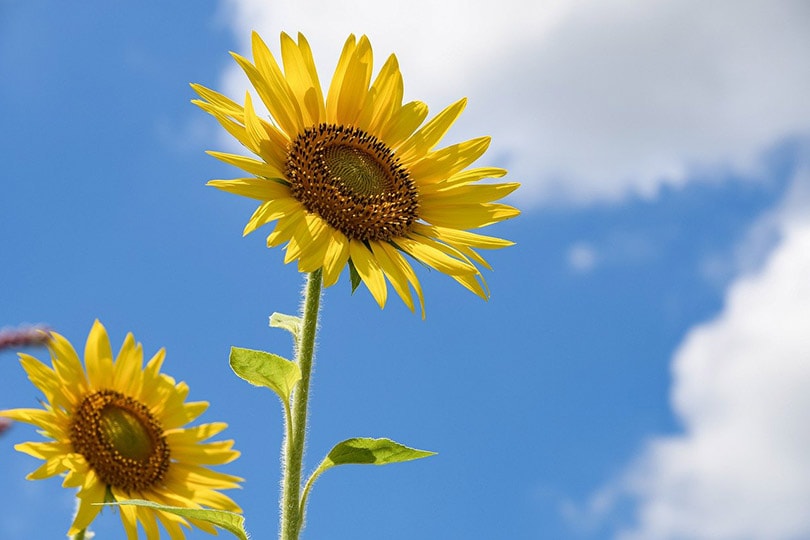
The state of Alaska boasts over 15,000 species of wildflowers. These spread out throughout two of Alaska’s natural forests, namely Chugach National Forest, which surrounds Prince William Sound, and Tongass National Forest, which spreads through most of southeastern Alaska. They are not limited to this region alone. Wildflowers can be found naturally growing in almost any corner of the state.
In this wildflower identification guide, we will look at some of the most common wildflowers growing in Alaska. We will also highlight the growing information of the flowers with accompanying photos for easier identification of Alaska’s wildflowers. Read on to learn more.
The 11 Wildflowers That Grow in Alaska
1. Yellow Marsh Marigold (Caltha palustris)
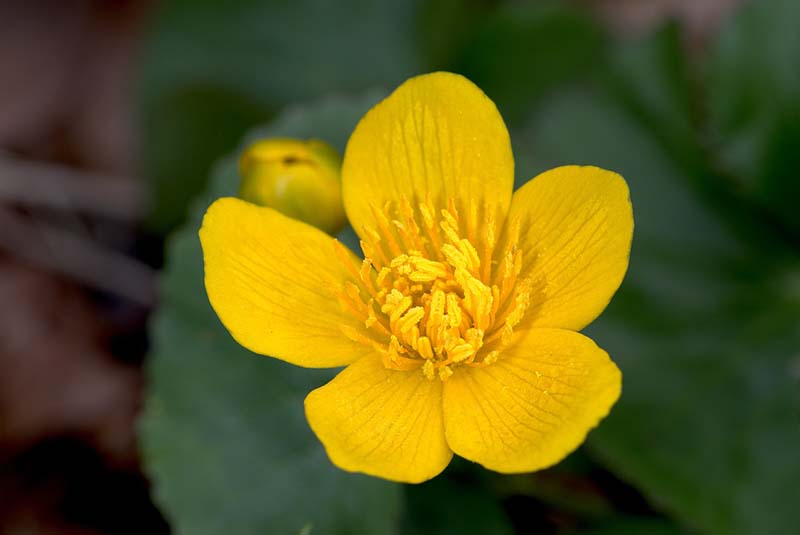
| Other names: | Yellow gowan, water buttercup, cowslip, kings cup |
| USDA Hardiness Zone: | 3–7 |
| Life Cycle: | Perennial |
| Approximate Mature Size: | 8–24 inches (20–61 cm) tall |
| Bloom Time: | Spring |
| Sun Exposure: | Full sun glare to partial sun |
The yellow marsh marigold flower is a type of aquatic plant that thrives in Alaska. Despite its name, the yellow marsh marigold is not a true marigold. It is actually a member of the buttercup species.
It grows in wet woods, marshes, ditches, and swampy areas. For this plant to thrive, the weather conditions need to be at least cool and wet. These flowers are popular among Alaskan natives as they eerily resemble a goblet.
They are early bloomers and attract the first butterflies from hibernation and hummingbirds in spring. If you are a gardening enthusiast, you will enjoy growing this disease-resistant and low-maintenance wildflower. You can grow them along shallow water bodies or in water gardens. However, make sure they get enough sunlight to promote more blooms.
2. Dandelion (Taraxacum officinale)
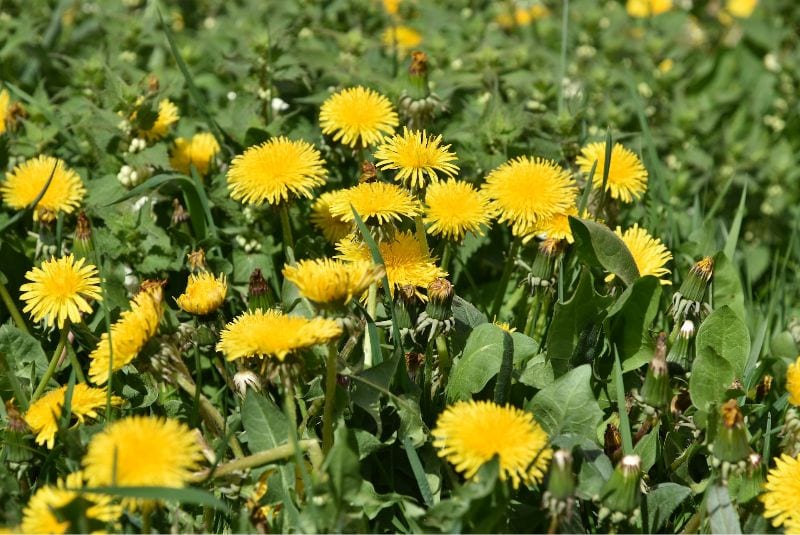
| Other names: | Lion’s tooth, common dandelion, blowball |
| USDA Hardiness Zone: | 3–10 |
| Life Cycle: | Perennial |
| Approximate Mature Size: | 6–12 inches (15–30 cm) tall |
| Bloom Time: | Spring to fall |
| Sun Exposure: | Full sun |
Dandelions are common wildflowers in Alaska; they are easy to recognize from their unique physical attributes. They feature bright yellow flowers that turn into silver tufted seeds when the petals wilt. You can find them thriving in river shores, fields, lakes, meadows, and disturbed habitats.
This dandelion species may be indigenous to Asia and Europe; however, it has spread out throughout the world due to its resilience, especially in moist soil conditions. You can find them growing like weeds on roadsides and lawns.
Despite behaving like a weed, the dandelion is edible, starting with the leaves, flowers, and roots. When you eat them fresh, they taste like honey; however, when the plant ages, the flavor turns bitter. They are popularly used to make wine, salad, tea, or jam. The flower attracts honeybees and other beneficial insects, which help the flower with the pollination process.
3. Yellow Lady’s Slipper (Cypripedium parviflorum)

| Other names: | Moccasin flower |
| USDA Hardiness Zone: | 3–8a |
| Life Cycle: | Perennial |
| Approximate Mature Size: | 8–30 inches (20–76 cm) tall |
| Bloom Time: | Spring to summer |
| Sun Exposure: | Partial shading |
The yellow lady’s slipper is easily identifiable from its purple-striped sepals and petals that surround a bright yellow pouch. The blossoms of this flower tend to look like delicate shoe designs for women, hence the name. This wildflower species grows in lake and river shoes, forests, thickets, and scrublands. Its bright colors attract a variety of beneficial insects, particularly bees.
This is perhaps why the yellow lady’s slipper is spread across Alaska’s landscape. If you want to improve the aesthetics of your garden, this wildflower is the most common and easiest orchid species you can plant. For the wildflower to thrive and produce unique blooms, ensure that it is planted in well-draining soil and is positioned under partial shade.
4. Wild Parsnip (Pastinaca sativa)
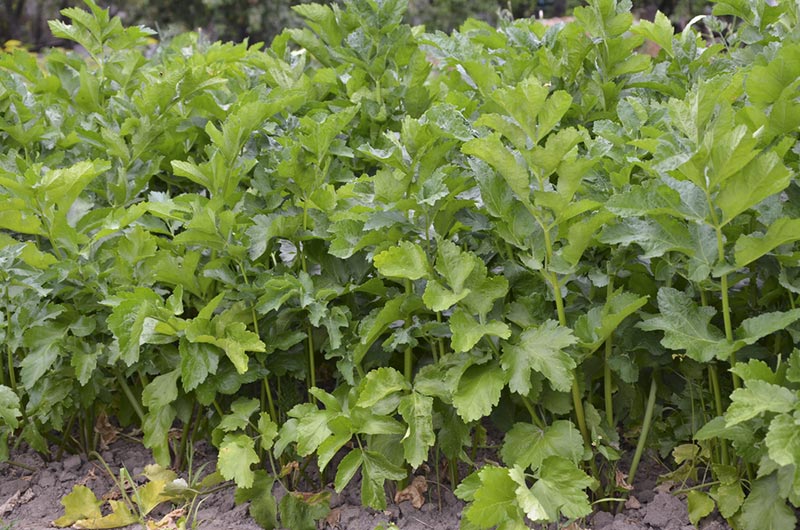
| Other names: | Common parsnip |
| USDA Hardiness Zone: | 4–8 |
| Life Cycle: | Biennial or perennial |
| Approximate Mature Size: | 48–59 in (122–150 cm) tall |
| Bloom Time: | Early summer |
| Sun Exposure: | Full sun to partial sun |
Most people are familiar with the parsnip plant grown in vegetable gardens. The plant is a common ingredient in most kitchens because of the delicious root vegetables. However, the close relative that grows in the wild is dangerous to human health when consumed.
The wild parsnip species may taste and look like the cultivated species; however, their stems and leaves can cause severe burns and blisters when touched. To identify a wild parsnip, simply look for its flat-topped flower clusters with yellow blooms and grooved stems.
The wild parsnip is considered invasive, especially in North America, because it spreads fast, almost choking out any native plant species. The yellow blooms from parsnip can be spotted on roadsides, in ditches, and in abandoned fields in spring. It poisons livestock everywhere it grows.
5. Wintercress (Barbarea vulgaris)

| Other names: | Herb Barbara, yellow rocket |
| USDA Hardiness Zone: | 5–9 |
| Life Cycle: | Biennial or perennial |
| Approximate Mature Size: | 12–24 in (30–61 cm) tall |
| Bloom Time: | Late spring to summer |
| Sun Exposure: | Partial shade |
The wintercress is one of the most resilient wildflowers growing in Alaska. It may be native to North Africa, Europe, and Asia, but it is considered a weed by Alaskan natives.
This plant is known to decorate the fields with yellow blooms, especially in early spring. You can easily recognize it from its dark green leaves and tall upright stalks.
It grows mostly on construction sites, croplands, railroads, roadsides, and waste areas. It may be an invasive plant, but it supports wildlife. It is a source of pollen and nectar to bees and butterflies in early spring. Grosbeaks and doves are also known to enjoy their seeds.
6. Goldenrod (Solidago)
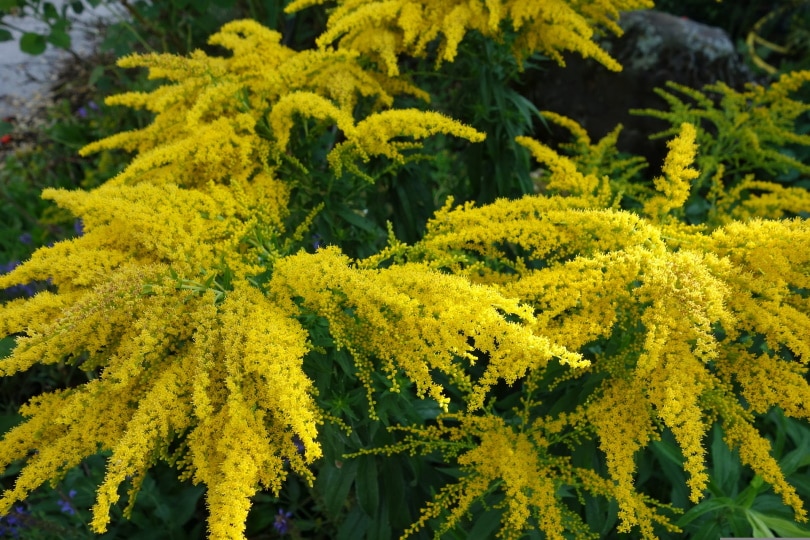
| Other names: | Canada goldenrod, flat-topped goldenrod, tall goldenrod |
| USDA Hardiness Zone: | 3–9 |
| Life Cycle: | Perennial |
| Approximate Mature Size: | 36–60 in (91–152 cm) tall |
| Bloom Time: | Late summer to fall |
| Sun Exposure: | Full sun |
North America is home to over 120 species of goldenrod wildflowers. Granted, they may be smaller blooms than the other plants on our list, but they more than make up for their small size with their vibrant colors in summer and fall. The goldenrod is identifiable from its clusters, which grow on top of branched stems as well as their stiff leaves.
Usually, goldenrod is blamed for spreading hay fever from their pollen grains, but some plants that share similar features, like ragweed, are also likely culprits.
Nevertheless, it is perfectly safe to enjoy their unique blooms but be warned: goldenrods are aggressively invasive wildflowers in gardens. If they are threatening to choke out your garden plants, you can control their spread by pruning regularly or potting the plant. They also attract a variety of butterflies, beetles, and specialized bees, which rely on the plant for sustenance.
7. Common Mullein (Verbascum thapsus)
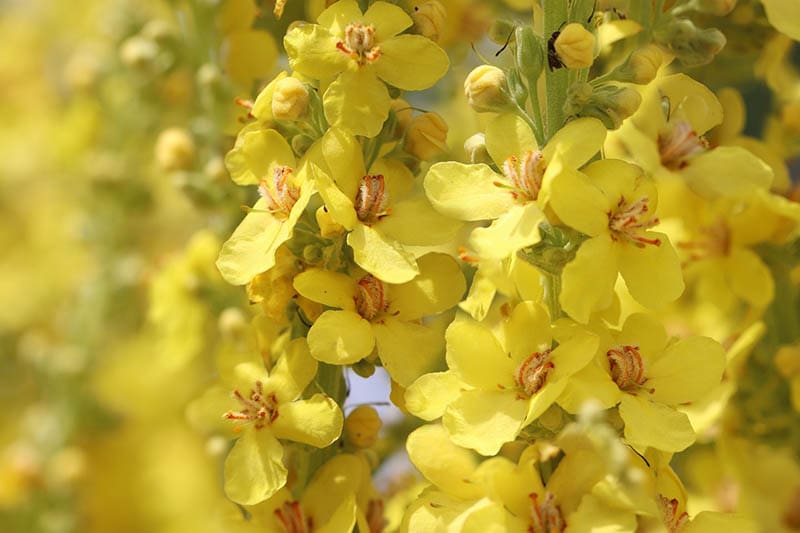
| Other names: | Big taper, flannel plant, velvet dock |
| USDA Hardiness Zone: | 3–9 |
| Life Cycle: | Annual or biennial |
| Approximate Mature Size: | 24–84 in (61–213 cm) tall |
| Bloom Time: | Summer |
| Sun Exposure: | Full sun |
Common mullein is a wildflower native to Asia, Africa, and Europe. However, it is considered a naturalized plant species in Alaska. The common mullein grows and thrives in almost any condition and can easily take over meadows, roadsides, and pasturelands.
This wildflower is recognizable from its yellow blooms, which densely cluster on a tall stem. The leaves are also dense and velvety and are found at the base of this wildflower. When the stems shoot up from the base covered with large leaves, the common mullein usually assumes the appearance of corn.
Besides being aesthetically pleasing, the common mullein also has some medicinal value. Traditionally, it was used to treat inflammations, pulmonary diseases, and other ailments. Today, its flowers, leaves, and oil extracts are sold in health stores.
8. Sulphur Cinquefoil (Potentilla recta)

| Other names: | Upright cinquefoil, round-fruited cinquefoil |
| USDA Hardiness Zone: | 3–8 |
| Life Cycle: | Perennial |
| Approximate Mature Size: | 12–20 in (30–51 cm) tall |
| Bloom Time: | Late spring to summer |
| Sun Exposure: | Full sun to partial sun |
The sulphur cinquefoil is an aggressively invasive species found in Alaska. This wildflower is native to Asia, Europe, and Africa and can easily threaten ecosystems and native plants if left to its devices. So, avoid planting it in your home garden.
While growing in the wild, the cinquefoil can thrive in almost any habitat. You can look for its leafy stems and five-petal blooms in fields, wastelands, disturbed areas, and along lake shorelines.
Sometimes people confuse sulphur cinquefoil with slender cinquefoil because they share similar physical attributes. The slender species can be grown in home gardens. It has tiny hairs on the leaves and stems, and features blooms that are brighter than those from the counterpart.
9. Common Sunflower (Helianthus annuus)
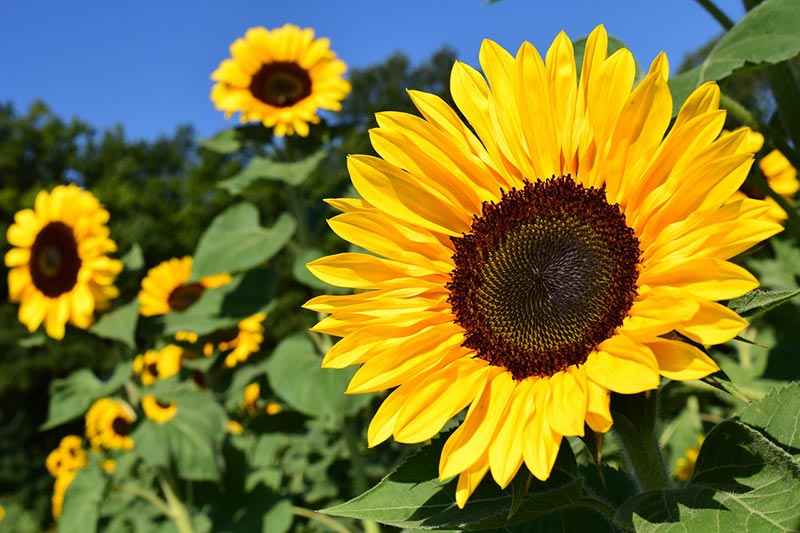
| Other names: | Comb flower, wild sunflower, St. Bartholomew’s star |
| USDA Hardiness Zone: | 2–11 |
| Life Cycle: | Annual |
| Approximate Mature Size: | 36–120 in (91–305 cm) tall |
| Bloom Time: | Summer |
| Sun Exposure: | Full sun |
The common sunflower is one of the most widespread and popular wildflowers in the world, and for good reason. The plant features large yellow petals with beautiful dark centers. The blooms are a spectacular sight, especially in late summer and early fall.
While growing wildly, you can find the common sunflower thriving in grasslands, roadsides, prairies, old fields, and forest edges. You can also marvel at their beauty in home gardens where they are enjoyed by people and animals. Besides their beauty, common sunflowers are also beneficial to butterflies, bees, and insect pollinators. Mammals and birds are also known to feed on the seeds. The seeds make a tasty snack for humans too.
10. Buttercups (Ranunculus)

| Other names: | Water crowfoots, spearworts |
| USDA Hardiness Zone: | 4–10 |
| Life Cycle: | Annual or biennial |
| Approximate Mature Size: | 8–18 in (20–46 cm) tall |
| Bloom Time: | Early spring to summer |
| Sun Exposure: | Full sun to partial sun |
Most people may be familiar with the popular buttercup plant, but what many do not know is that it is a member of a genus with over 600 unique species spread across the world. One of the most popular genera of the buttercup species is the Persian buttercup, which is popular for its tall stems and bright ruffled petals.
The buttercup wildflower species is noticeable from its bright yellow colors, which sometimes can bloom in shades of red, cream, purple, pink, and orange. The blooms make excellent flower arrangements in homes and can attract beneficial pollinators when growing in your yard. In Alaska, you can find this yellow wildflower in fields, roadsides, meadows, and moist environments.
11. Spiny Sow Thistle (Sonchus asper)
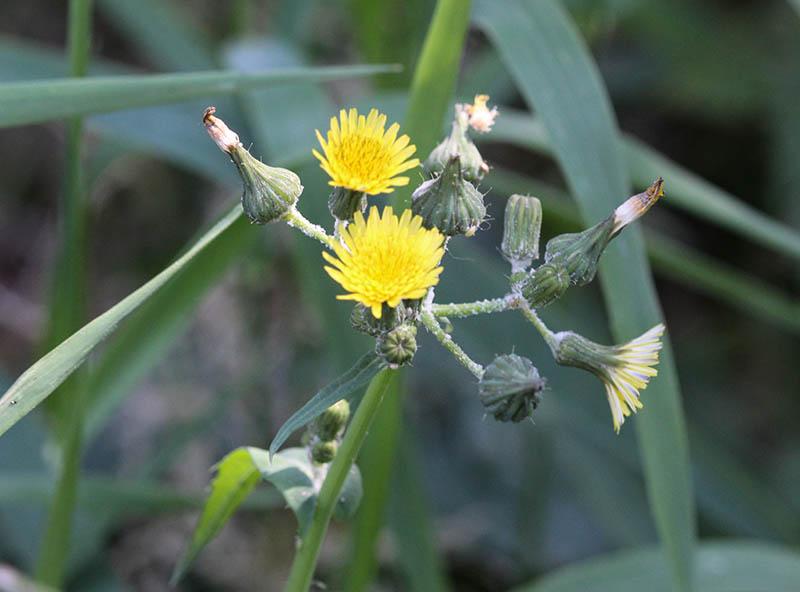
| Other names: | Rough milk thistle |
| USDA Hardiness Zone: | 6b–9a |
| Life Cycle: | Annual or biennial |
| Approximate Mature Size: | 11–43 in (28–110 cm) tall |
| Bloom Time: | Spring to summer |
| Sun Exposure: | Full sun to partial shade |
Spiny sow thistle may be native to Asia, Europe, and North Africa, but this invasive wildflower also grows and thrives in Alaska. It grows in vacant lots, grasslands, roadsides, construction sites, and waste areas.
If this wildflower makes its way into your yard, do not give it even an inch. It can spread and threaten to choke out your priced vegetables. Furthermore, it is a pest and disease carrier that can affect the crops and flowers in your garden. To identify this aggressive yellow wildflower, look for a plant with tall stems, spiky leaves, and yellow flowers that closely resemble those of a dandelion.
Conclusion
Alaska may have a bleak climate at most times of the year, but during summer, various blooms from different wildflowers that grow and thrive in the state transform the landscape. This is because, over the years, the plants have adapted to withstand cold temperatures and great winds in high mountainous regions.
They often display colorful blooms of colors that grow close to the ground or have insulating qualities that protect them from the chill. This is perhaps why wildflowers are spread out all over Alaska.
We hope our descriptions, photos, and growing information will make it easier to identify the wildflowers while out in the field or hiking the Alaskan landscape.
Related Reads:
- 50 Wildflowers That Grow in Montana (Identification Guide with Pictures)
- 16 Wildflowers That Grow in Indiana (Identification Guide with Pictures)
Featured Image Credit: Johnnys_pic, Pixabay
Contents

